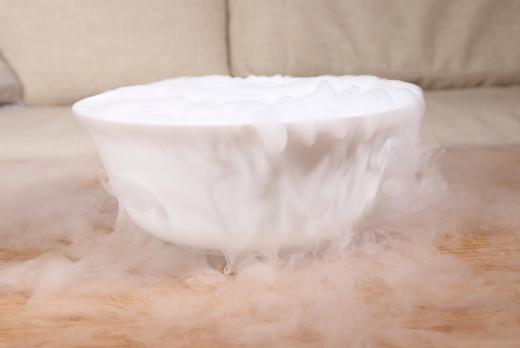What is a Melting Point?
Most people have seen an object melting, such as ice melting into water on a hot day. The melting point of an object is the point at which the solid object turns into a liquid. A more scientific way of saying it is that it is the point at which a pure substance's solid and liquid states are at equilibrium. This point is unique for pure substances, so scientists can use the temperature as one way to identify a particular substance.
When heat is applied to a solid object, the molecules within the solid start to move faster. As more heat is applied, the molecules in the solid continue to move until the attractive forces holding the molecules in a packed shape are overcome by the amount of energy the molecules have. At that point, the solid melts and the substance becomes a liquid. Even if more heat is applied to an object once it has started melting, the object will not change temperature until all the solid has become a liquid. No matter how much heat is applied to an ice cube, for example, the ice and water will remain at 32°F (0°C) until all the ice has melted.

Many people are familiar with the melting and boiling points of water. Water usually melts and freezes at 32°F (0°C) and boils at 212°F (100°C). The familiarity of water may make the melting points of other substances extreme by comparison. For example, the temperature at which carbon melts is 6,422°F (3,550°C), while mercury melts at -37.97°F (-38.87°C).

The melting point of a substance is often the same as the freezing point, but this isn't always the case. Some liquids are able to be supercooled. Supercooling a liquid is the process by which someone is able to cool a liquid past its freezing point without it turning into a solid. Such a liquid has to be pure because a single crystal, impurity, or sometimes even just movement will cause the liquid to crystallize. Should the supercooled liquid encounter such an impurity or movement, it will freeze almost instantaneously.
There are also objects that do not commonly have a melting point. One of the most famous and well used substances that does not have one at atmospheric pressure is carbon dioxide. Carbon dioxide's solid phase is commonly called "dry ice." At -109.3°F (-78.5°C), carbon dioxide jumps from its solid phase to its gas phase in a process called sublimation. Carbon dioxide only occurs as a liquid at pressures that exceed five atmospheres.
AS FEATURED ON:
AS FEATURED ON:












Discussion Comments
One of the cool things that they are bringing out for kitchens soon is a dry ice machine that you can use to make really unique desserts. I saw it demonstrated on a show. I guess because the carbon dioxide goes from gas to solid without a liquid phase, dry ice gives off that vapor that looks like steam, so all the people demonstrating and trying the desserts were breathing out big billowing breaths, which the kids really liked.
But mostly they were demonstrating how you could freeze things like custards so that they were crunchy on the outside but still liquid in the middle. I guess that's because it happens so fast that the center doesn't reach the freezing point.
@indigomoth - Actually it does happen in nature. It's one of the dangers of flying through rain clouds that they contain drops of supercooled water which might crystallize on the plane wings when it flies past. So, in that case, I guess it's more a matter of figuring out how to stop that from happening than anything else.
Although, actually, it sounds difficult and maybe it is with other kinds of liquid, but you can do it in your own freezer if you're careful. Or you can do it to demonstrate how melting and freezing points work to students. There are plenty of tutorials online. Mostly you just need to ensure that your water is very pure and cold for it to work. Then you can make it instantly freeze and impress your friends (if they are easily impressed!).
I actually didn't realize that was the definition of a supercooled liquid. I had heard the term before, but just assumed it was a substance that could be naturally cooled to a very low temperature before it froze solid.
I feel like I've heard the term used a fair amount but when I looked up the applications of supercooled liquids it seems like they are mostly used to make slushy drinks! It seems like a pretty amazing and precise process to be used in making novelty beverages.
Post your comments